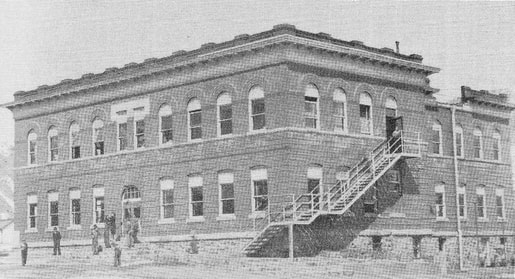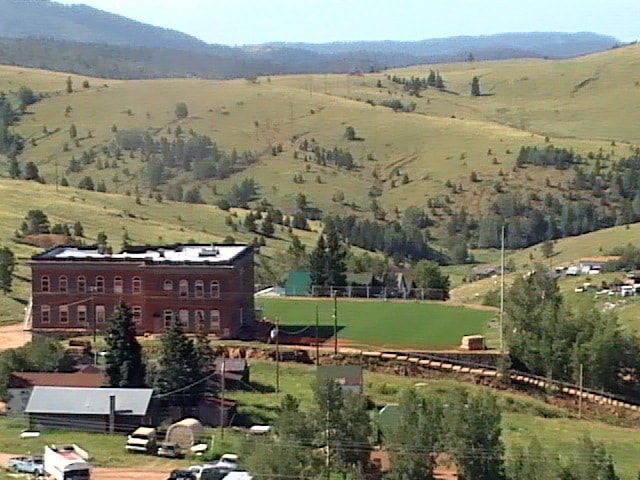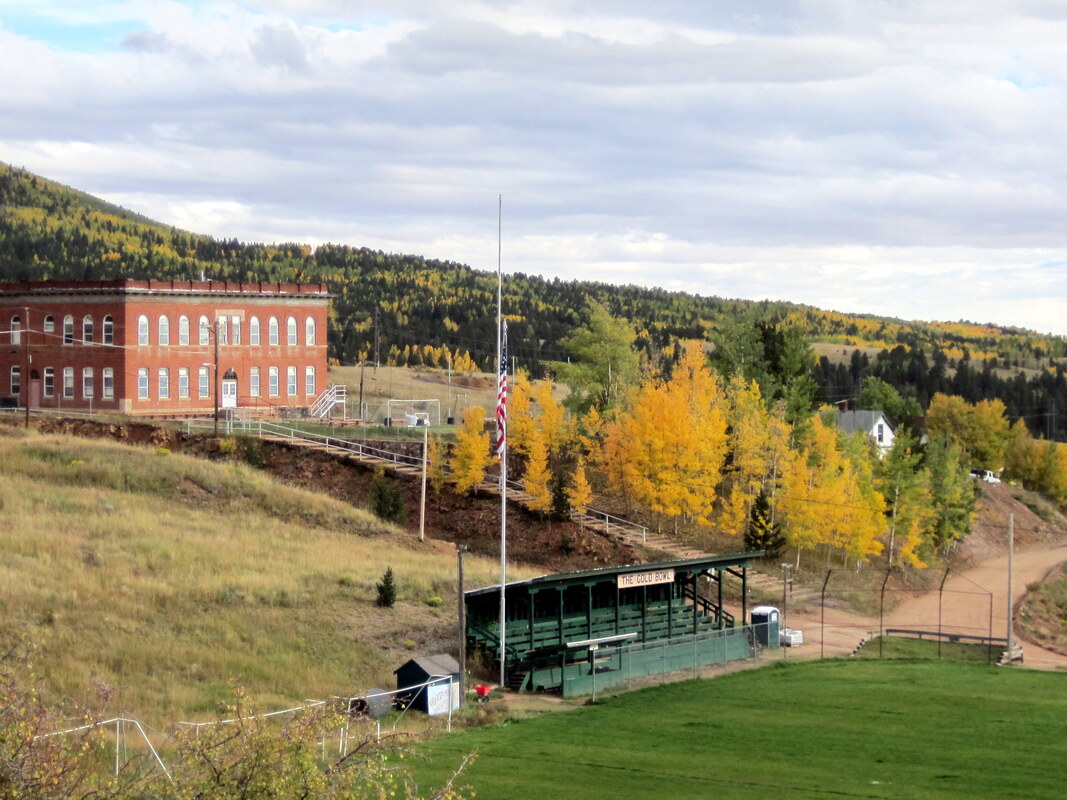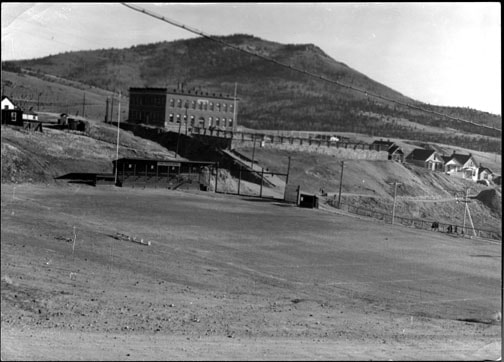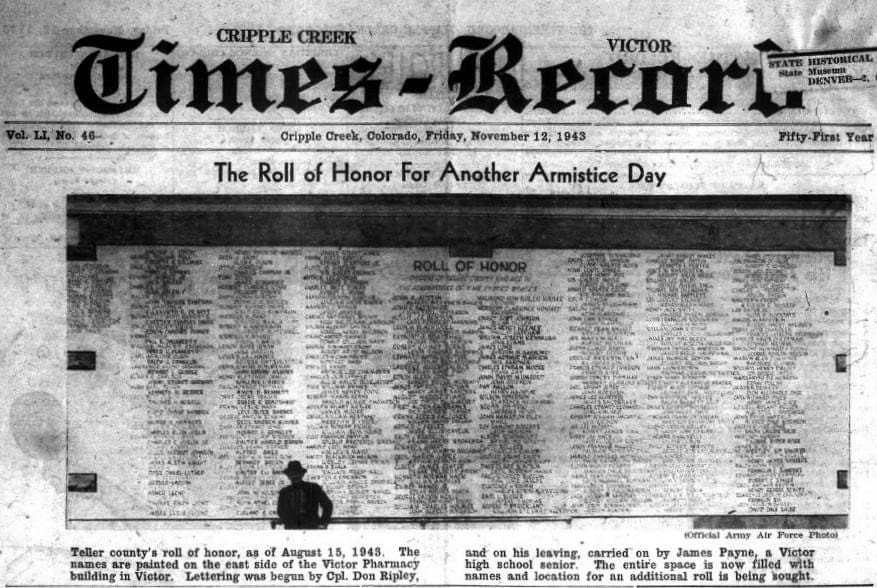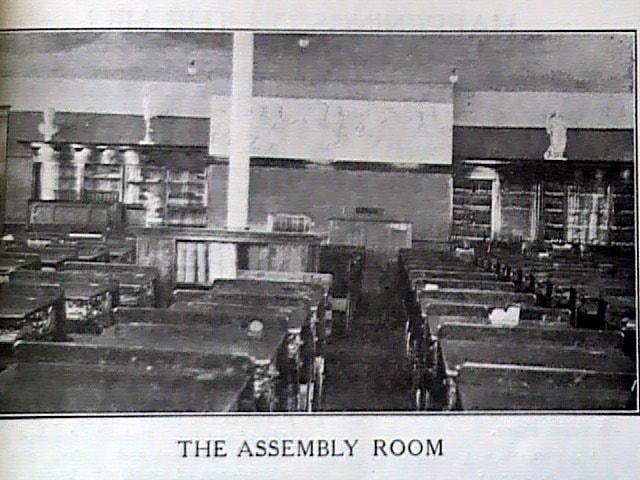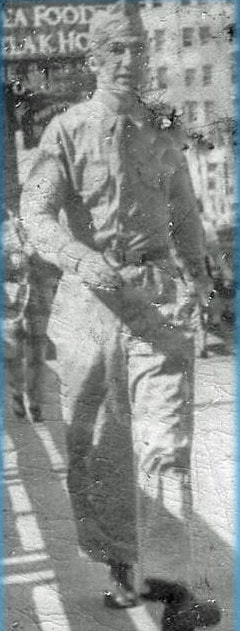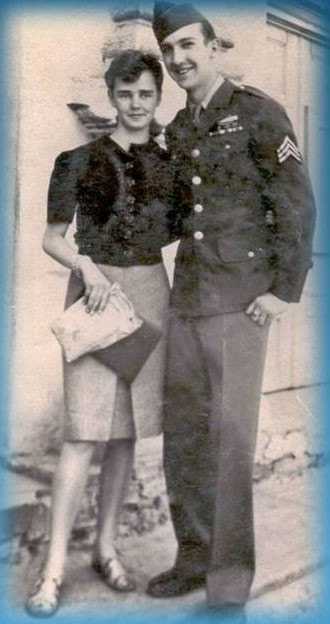Memories of James Garth Payne & How He Came to Letter Names on the Original WWII Roll of Honor in Victor and Cripple Creek, Colorado. Submitted by Marjorie Payne (daughter-in-law).
JAMES GARTH PAYNE
Prior to Living in Victor, Colorado & His WWII Military Service
(Summarized by Marjorie Payne)
Prior to Living in Victor, Colorado & His WWII Military Service
(Summarized by Marjorie Payne)
James Garth Payne was born August 11, 1925, to James Edwin Payne and Josephine Beatrice Willis Payne, in Cassidy, Kansas. The Payne family lived in a section house owned by the Santa Fe Railroad. I will refer to James Garth Payne as James G., and his father as James E.
Cassidy was a small town, and everyone was poor due to the depression. James G. described his parents as very loving and caring to both himself and his older brother, William (Billy), who was born in 1920.
James E. Payne ran a section crew to repair the railroad tracks, Josephine took care of the kids. According to James G. Payne they were a little better off than most, since the railroad paid well. He commented that nobody in the neighborhood cared about how well off anyone was, they were a loving caring bunch of people.
When James G. was young, he loved looking at the World Book Encyclopedias, especially the sculptures of ancient Greece and the Roman Empire. He also remembered wishing he could read the fairy tales in those books, he really loved the pictures.
When James. G. was only 6 years old, his father and older brother were killed in a tragic accident. James E. was stoking a coal stove in the kitchen with Billy nearby. It exploded. Billy died a short time after the accident and James Edwin Payne passed a few hours later.
After Josephine remarried Tony Kelso, a few years later, they relocated to Colorado with James G. Here the story continues in James' own words.
Cassidy was a small town, and everyone was poor due to the depression. James G. described his parents as very loving and caring to both himself and his older brother, William (Billy), who was born in 1920.
James E. Payne ran a section crew to repair the railroad tracks, Josephine took care of the kids. According to James G. Payne they were a little better off than most, since the railroad paid well. He commented that nobody in the neighborhood cared about how well off anyone was, they were a loving caring bunch of people.
When James G. was young, he loved looking at the World Book Encyclopedias, especially the sculptures of ancient Greece and the Roman Empire. He also remembered wishing he could read the fairy tales in those books, he really loved the pictures.
When James. G. was only 6 years old, his father and older brother were killed in a tragic accident. James E. was stoking a coal stove in the kitchen with Billy nearby. It exploded. Billy died a short time after the accident and James Edwin Payne passed a few hours later.
After Josephine remarried Tony Kelso, a few years later, they relocated to Colorado with James G. Here the story continues in James' own words.
JAMES GARTH PAYNE'S MEMOIRS
In His Own Words
In His Own Words
We came by train from Lawrence, Kansas to Colorado Springs, Colorado. We arrived on a cold and foggy morning. We connected to a place to stay while we got our plans together before going on to Victor. It happened that the place where we stayed had a man who drove a sightseeing bus up Pike’s Peak, and I got to ride with him free of charge. While we were at the top a guy was photographing and got too close to the edge of the bottomless pit and fell over the edge. Thank God it was not bottomless for him; he fell about 30 feet onto a ledge. They were able to rescue him, and it really made an impression on me. I guess that’s why I’m afraid to get near the edge of any high place!
We stayed in Colorado Springs for a couple of days and then caught the little train that ran up to the Cripple Creek District. We got a hotel in Victor and the first thing that impressed me was the high prices of everything; a hamburger at the café was $ 0.35, but it was big and juicy as I remember!
Mom and Tony enrolled me in the public school and decided that Colorado was ahead of Kansas in education so I should be held back a grade. I didn’t mind and I think it helped me as I was able to use some of my Kansas learning to get a good grade at the end of the first year.
We found a house that belonged to Lillian Tittmas whose parents had passed away and she lived elsewhere. It was an old 2-story house and upon entering there was a stairway up to the second floor where there were two rooms. I claimed the front one that had a window facing out to the street.
There was only one paved street that ran through town. All the side streets were dirt, rock or gravel. Lillian Tittmas sold us the house for $300 cash which we paid with my dad’s insurance. With that, we were also able to pay for a company to bring our furniture and belongings to Victor. The moving truck went off the road in the high mountains getting there and dumped what was left of the furniture in the front yard. Tony tried to glue some of the furniture back together to no avail. The moving company paid mom and dad damages for wrecking the furniture.
A little girl that lived next door watched as our possessions were dumped in the yard. That little girl later became my darling wife!
We stayed in Colorado Springs for a couple of days and then caught the little train that ran up to the Cripple Creek District. We got a hotel in Victor and the first thing that impressed me was the high prices of everything; a hamburger at the café was $ 0.35, but it was big and juicy as I remember!
Mom and Tony enrolled me in the public school and decided that Colorado was ahead of Kansas in education so I should be held back a grade. I didn’t mind and I think it helped me as I was able to use some of my Kansas learning to get a good grade at the end of the first year.
We found a house that belonged to Lillian Tittmas whose parents had passed away and she lived elsewhere. It was an old 2-story house and upon entering there was a stairway up to the second floor where there were two rooms. I claimed the front one that had a window facing out to the street.
There was only one paved street that ran through town. All the side streets were dirt, rock or gravel. Lillian Tittmas sold us the house for $300 cash which we paid with my dad’s insurance. With that, we were also able to pay for a company to bring our furniture and belongings to Victor. The moving truck went off the road in the high mountains getting there and dumped what was left of the furniture in the front yard. Tony tried to glue some of the furniture back together to no avail. The moving company paid mom and dad damages for wrecking the furniture.
A little girl that lived next door watched as our possessions were dumped in the yard. That little girl later became my darling wife!
|
Our home was located on the downside of a hill at 119 South 6th Street. I would run up that hill everyday as I loved running.
I went straight down Main Street and over to the school. It was high on a hill about a half mile from our house. I had to climb about a hundred steps to get to where the school was! |
This huge stairway to the school was built by the WPA, one of the organizations formed by the government under President Roosevelt to put America to work during the depression. It was built good and still stands today.
I enjoyed going to school and made some good friends in the classrooms. When we weren’t in school, we would hang out at Harshbarger’s Soda Fountain drinking Pepsi Cola. I used to race one of my best friends, Rex Johnson, around the block and whoever won was awarded a Pepsi!
|
Life in Victor was simple. I did pretty good in school and played basketball and football. I wasn’t outstanding in either, but I loved to run so I was put at the end of the line. Rex Johnson and I were the two fastest ones on the team. We played at the Gold Bowl which was blasted out of solid rock and had a little gravel on top. It really roughed you up when you threw a block or got tackled! We stayed in pretty good shape as we practiced every day during the season. I built a high jump in my backyard and loved jumping over it. I also loved running up 6th Street and Main Street the half mile or so to school.
|
For enjoyment during the summer, we would play marbles and I got to be very good at it. We also played hide and seek in the evenings. One time we went to Bud Moss’s house and had toast with real butter and was it ever good! He had an automatic electric toaster; we owned a toaster that the sides flopped down to turn the bread around and had colored Oleo instead of real butter.
I also enjoyed picking up the mail for Harshbarger’s store; that way I was able to see all the new comic books that came in. I had the first Superman in Action comic and never realized it would later sell for 1.5 million dollars! I had the first appearance of Batman, too. I loved drawing those superheroes!
Our class had a sneak day and got to go to Denver and stay the night. That’s when I discovered Meininger’s Art Store and bought a book on lettering, Speed Ball Points and ink. Later when I got back home, I was able to letter signs for Harshbarger’s and the local restaurant.
I also enjoyed picking up the mail for Harshbarger’s store; that way I was able to see all the new comic books that came in. I had the first Superman in Action comic and never realized it would later sell for 1.5 million dollars! I had the first appearance of Batman, too. I loved drawing those superheroes!
Our class had a sneak day and got to go to Denver and stay the night. That’s when I discovered Meininger’s Art Store and bought a book on lettering, Speed Ball Points and ink. Later when I got back home, I was able to letter signs for Harshbarger’s and the local restaurant.
I bought brushes and learned to letter with them. My hero was an artist named Don Ripley who drew a wonderful comic strip for the local paper about a hard rock miner. His real job was bookkeeper for the Ajax Gold Mine. He lettered the Honor Roll on the side of a building downtown [then known as the Victor Pharmacy, now known as the Monarch Block]. When he left to serve in the Army, I picked up where he left off on the names. Because I did that, I ended up lettering the Honor Roll in Cripple Creek. I would hike the six miles over there to letter, sometimes thumbing a ride from a generous person. After that I added in the Victor High School students that went into the service.
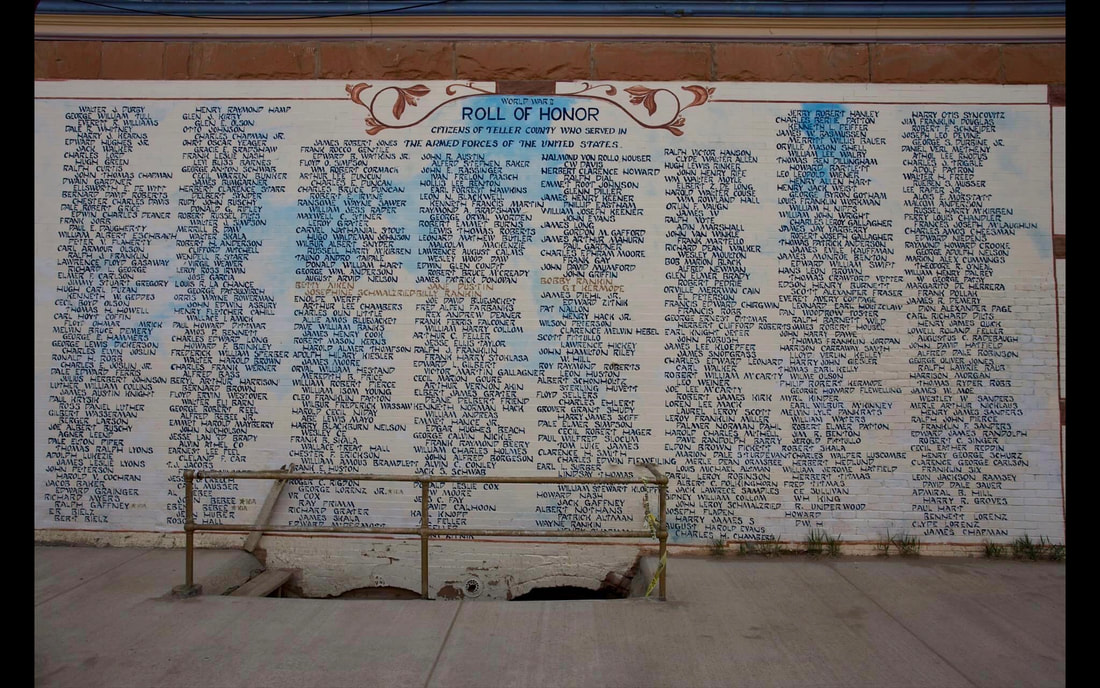
The original WWII Veterans Wall of Honor on the wall of the Monarch Block was repainted and expanded several times. Shown here is one of the later versions which was painted over by the current owner of the building in July of 2020. A new more permanent WWII Veterans Memorial was dedicated in Wallace Park on July 18, 2021.
The girl next door had moved away to Woodland Park. She wrote me a letter from there, thanks to her adoptive mother, Annabel. Sometimes our basketball team played against Woodland Park, so I was able to see her when our team played there. Later, I would bum a ride with the Rainbow Bread man who delivered to Victor and Cripple Creek. I would write to Charlotte about every day, and I helped her with her home economics class by typing her assignment, a bunch of recipes. Of course, the typewriter I used didn’t match the one at her school. I met the home economics teacher and she joked about it, a real nice and understanding teacher!
When Charlotte and I married on January 15, 1944, there was a blizzard; extremely cold with snow blowing across the highway. I was waiting for the stage (a station wagon) to bring Charlotte and her parents to Harshbarger’s store downtown. The stage arrived and announced they had let Charlotte and her family off at Mr. and Mrs. Johnson’s house where we were to be married, about four blocks away. I had a bunch of roses to give Charlotte and they didn’t stand the weather too good as I fought my way through the storm to the Johnson house. The preacher almost married Charlotte to my best man, Rex Johnson! My other best friend, Robert Eccher was on hand to photograph the whole event. The wedding was wonderful, but the pictures Robert took when developed were all fogged up so there isn’t any photographic evidence that we got hitched.
We spent our honeymoon night at the local hotel. The next morning, we had hot chocolates at Harshbarger’s store. Charlotte spilled her drink on her lovely dress. After that, we went to stay with my mom, Josephine and Tony Kelso, her husband until we found a nice apartment on the hill. It had an electric stove, and we heated a lot of soup and cooked some apples in the oven. There was a table tennis set in the lower floor by the washing machine and we played many games together.
When Charlotte and I married on January 15, 1944, there was a blizzard; extremely cold with snow blowing across the highway. I was waiting for the stage (a station wagon) to bring Charlotte and her parents to Harshbarger’s store downtown. The stage arrived and announced they had let Charlotte and her family off at Mr. and Mrs. Johnson’s house where we were to be married, about four blocks away. I had a bunch of roses to give Charlotte and they didn’t stand the weather too good as I fought my way through the storm to the Johnson house. The preacher almost married Charlotte to my best man, Rex Johnson! My other best friend, Robert Eccher was on hand to photograph the whole event. The wedding was wonderful, but the pictures Robert took when developed were all fogged up so there isn’t any photographic evidence that we got hitched.
We spent our honeymoon night at the local hotel. The next morning, we had hot chocolates at Harshbarger’s store. Charlotte spilled her drink on her lovely dress. After that, we went to stay with my mom, Josephine and Tony Kelso, her husband until we found a nice apartment on the hill. It had an electric stove, and we heated a lot of soup and cooked some apples in the oven. There was a table tennis set in the lower floor by the washing machine and we played many games together.
|
After our high school marriage, we were still allowed to attend school. Mr. Wilkerson, our principal, was a good friend of mine and I think it was by his influence that we got the job of painting the big assembly hall and the main hallways at the school. I also painted some signs for the school machine shop and did some carpenter work there. I was hired by my friend Robert Eccher’s mom to paint the inside of her boarding house. Because we got this job, one of the local painters called the IRS because he thought we were cutting into his business and making big bucks. The IRS agent concluded that we didn’t make enough to pay any taxes.
|
Although I had plenty to do, I decided to print my own newsletter, called “The Tattler”, which I printed out using a gelatin pad. It sold for a penny a copy and contained the latest school activities. As a result of this, I received a book as an award from the school for extra activity. The title of the book was “I Dare”, which encouraged one to always do better. It was nice of them.
|
It was right after graduation in June of 1944 that Uncle Sam called all seniors eligible for service to come on in. We were transported to Denver and spent a night at the Oxford Hotel downtown. In the morning, after a good breakfast, we were bussed to Fort Logan for induction into the U.S. Army and issued our G.I. outfits.
A couple days later and we were on a train headed for Little Rock, Arkansas. We trained at Camp Joseph T. Robinson. Our instructor was a veteran of the fight to keep the Japs from taking Alaska. He fought on Kiska and Attu in the snow and ice where they repelled the enemy. He was a great sergeant and really trained us to respect and know our M-1 rifles. It was very hot and dusty at the camp. I got the usual blisters on the feet from the twenty-mile hikes; also got the usual K-P duty, guard duty and cleanup the yard details. It was a good life, and I met a lot of fine guys while I was there. One day, I came back from the field hot and dirty, and the head office calls me in and tells me my wife was there. “No way!”, I said, “My wife is in Colorado!” They said to come take a look for yourself. I did, and it was enough to blow me over with a feather; Charlotte was there! They let her stay the night and arranged a place for her in Little Rock where she got a job at the local bus station in the restaurant. After our quarantine to the company area was up, I was able to get weekend leave and go to town to be with Charlotte. She was a very gutsy gal. She got on the wrong train at one of the change trains stops and ended up waiting in a field for the train to pick her up. The large group of soldiers on the train took her under their wing for the rest of the trip to Little Rock. |
|
It was in Little Rock that we learned about the feelings of the local people against blacks. I saw two water fountains in the department store that read “White” and “Colored”, so I turned on the “Colored” one, but it was just regular water. People looked at me and I finally got the message. I also tried to sit in the back of the bus because there was plenty of room there. The bus driver got out of his seat and came back to inform me that I couldn’t sit there as it was reserved for the colored customers. I learned a lot that day.
Further Comments by Marjorie Payne (daughter-in-law)
The memoirs Dad Payne sent me in a series of emails in 2010 went on to detail some of the places James and Charlotte lived after James G. left the military. As is often true of veterans of war, he did not share any information about his experiences during WWII. Not hard to understand. I am so proud of Dad Payne for his service and for the wonderful family he created. Click this highlighted LINK for a YouTube Video I created in his honor. |
"Memories of James Garth Payne & How He Came to Letter Names on the Original WWII Roll of Honor in Victor and Cripple Creek, Colorado" (submitted September 2021) by Marjorie Payne (daughter-in-law).
Concluding Note: The Teller County World War II Roll of Honor that for 77 years graced the wall of the Monarch Block at the corner of Victor Avenue & Third Street was painted over in 2020 by the new owner of the building. A new, more durable WWII Roll of Honor was constructed in Wallace Park (corner of Victor Avenue & Second Street) and dedicated on July 18, 2021. Click highlighted LINK for details about the new memorial.
THE PAST MATTERS. PASS IT ALONG.
The Next Generation Will Only Inherit What We Choose to Save and Make Accessible.
Please Share Your Memories and Family Connections to Victor & the World's Greatest Gold Camp
By Contacting Victor Heritage Society, PO Box 424, Victor, CO 80860 or e-mail [email protected].
The Next Generation Will Only Inherit What We Choose to Save and Make Accessible.
Please Share Your Memories and Family Connections to Victor & the World's Greatest Gold Camp
By Contacting Victor Heritage Society, PO Box 424, Victor, CO 80860 or e-mail [email protected].
VictorHeritageSociety.com
Copyright © 2023 Victor Heritage Society. All Rights Reserved.
Copyright © 2023 Victor Heritage Society. All Rights Reserved.
